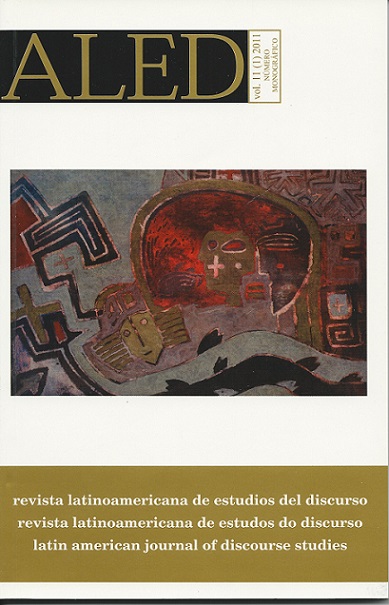Representación del consumo de drogas en historias de vida de personas en situación de calle en Santiago de Chile
¿A quiénes se está entrevistando y citando con frecuencia? Teun van Dijk. Discurso y poder
Keywords:
CDA. drug consumption. homeless people. argumentation. representation of social actors. life story.Abstract
The aim of this paper is to describe the discursive representation of the causes of drug consumption constructed in the discourse of a group of homeless people in Santiago de Chile, from the perspective of Critical Discourse Analysis. The data is composed of life stories of homeless people, from where we have selected topical episodes (Linell, 1998; Van Dijk, 1981) related to drug consumption. The analysis of the data considered argumentative macro-strategies (Toulmin, 1963/2003) and micro-strategies of representation of social actors in the discourse (van Leeuwen, 2008). The results indicate that the family plays a key discursive role in the explanation of the causes of the drug consumption of the speaker. However, at the same time, the speaker presents itself as an active and responsible discursive actor in relation to his drug consumption. Although the data analyzed is small, these results allow us to question some of the most common prejudices against drug consumers that are, at the same time, homeless people.
Downloads
References
Eggins, S. (2002). La gramática del significado experiencial: la transitividad. Introducción a la lingüística sistémica. Logroño: Universidad de La Rioja.
Fairclough, N. (1993). Discourse and social change. Cambridge: Polity.
Fairclough, N. (2003). Analysing discourse. Textual analysis for social research. London: Routledge.
Folgar, L. (2002) Aportes antropológicos sobre la construcción del tema “drogas” (pp. 25-38). En Anuario Unesco. Antropología Social y Cultural en Uruguay. 2002-2003. Obtenido el 20 de diciembre de 2008 desde http://www.unesco.org.uy/shs/fileadmin/templates/shs/archivos/anuario2002/Anuario02-03.pdf
Galdames, M. (2004). La pobreza en Chile. Obtenido el 15 de enero de 2009,desde boletin.fundacionequitas.org/n_individuales/V-5.pdf
Halliday, M. (1994). An introduction to functional grammar (2° ed.). London: Edward Arnold.
Hanson, G., P. Venturelli y A. Fleckenstein. (2002). Drugs and society. Boston: Jones and Bartlett.
Linde, Ch. (1993). Life Stories. The creation of coherence. Oxford: University Press.
Linell, P. (1998). Approaching dialogue. Talk, interaction and contexts in dialogical perspectives. Philadelphia: John Benjamins.
Linell, P. 2009. Rethinking Language, Mind and World Dialogically: Interactional and contextual theories of human sense-making. Charlotte, NC: Information Age Publishing.
Mideplan (2005). Habitando la calle. Catastro nacional de personas en situación de calle. Obtenido el 10 de mayo de 2008, desde www.fundacionpobreza.cl/Biblioteca/Archivos/Bajar.asp?Carpeta=POBREZA&Archivo=Habitando%20la%20calle.pdf
Montecino, L. (2010). “Historias de vida” de personas en situación de calle de Santiago de Chile: descripción de una práctica discursiva. En Montecino,
L. (2010) Discurso, pobreza y exclusión en América Latina, pp. 245-272. Santiago: Cuarto Propio.
Ortiz, N. y M. Silva. (2005) Significados y contradicciones del fenómeno de las drogas: drogas lícitas e ilícitas en Chile. Rev Latino-am Enfermagem 2005 setembro-outubro; 13(número especial): 903-11. Obtenido el 20 de diciembre de 2008 desde http://www.scielo.br/pdf/rlae/v13nspe/v13nspea19.pdf
Pardo Abril, N. (2007). Cómo hacer análisis crítico del discurso. Una perspectiva latinoamericana. Santiago: Frasis.
Pardo, M. L. (2008). Una metodología para la investigación lingüística del discurso. En M.L. Pardo (ed.) El discurso sobre la pobreza en América Latina, pp.55-78. Santiago: Frasis.
Rojas, N. (2006). Personas en situación de calla en la perspectiva de la exclusión y la vulnerabilidad Social. Obtenido el 20 de diciembre de 2008 desde http:// www.redcalle.cl/descripdecla.asp?ImageID=299
Toulmin, S. (1963/2003) Los usos de la argumentación. Barcelona: Península.
van Dijk, T. (2010). Prejuicio en el discurso. Sevilla: ArCiBel.
van Dijk, T. (2009). Discurso y poder. Barcelona: Gedisa.
van Dijk, T. (2000). Ideología. Una aproximación interdisciplinaria. Barcelona: Gedisa.
van Dijk, T. (1997). Racismo y análisis crítico de los medios. Barcelona: Paidós.
van Dijk, T. (1981). Episodes as units of discourse analysis, en D. Tannen (ed.) Analyzing discourse: Text and talk, pp. 177-195. Georgetown: Georgetown University Press.
van Leeuwen, T. (2008). Discourse and Practice. New tools for critical discourse analysis. Oxford: Oxford University Press.
Vasilachis, I. (2003). Pobres, pobreza, identidad y representaciones sociales. Barcelona: Gedisa.
Wodak R. y Meyer M. (2003). Métodos de análisis crítico del discurso. Barcelona: Gedisa.
Downloads
Published
How to Cite
Issue
Section
License

This work is licensed under a Creative Commons Attribution-NonCommercial-NoDerivatives 4.0 International License.
The authors retain the copyright and guarantee RALED the right to be the first publication of the work as well as a Creative Commons Attribution License that allows others to share the work with recognition of authorship and the initial publication in this journal.




